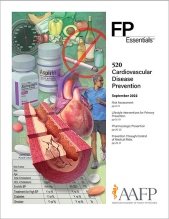
This clinical content conforms to AAFP criteria for CME.
The fact that up to one-third of the 800,000 yearly cardiovascular disease (CVD) deaths in the United States may be preventable by diet and physical activity makes a compelling case for lifestyle interventions as a primary prevention strategy. The U.S. Preventive Services Task Force (USPSTF) recommends offering or referring adults with CVD risk factors to behavioral counseling interventions to promote a healthy diet and physical activity. Although few US adults have ideal cardiovascular health, there exists a dose-response relationship whereby an increasing number of ideal cardiovascular health metrics is associated with lower CVD and all-cause mortality. The Dietary Approaches to Stop Hypertension (DASH) diet and the Mediterranean diet have proven benefits in reducing CVD. Among individuals without CVD, high levels of physical activity are associated with an approximately 32% reduced risk of CVD death, and moderate levels are associated with approximately a 22% reduction. Resistance exercises confer additional benefits.
Case 2. ML is a 52-year-old woman with mild intermittent asthma, allergic rhinitis, and mild generalized anxiety disorder managed with cognitive behavioral therapy. She is fairly sedentary at her job and at home. She is 65 inches tall with a current weight of 76 kg (167 lb) and a body mass index (BMI) of 27.8 kg/m2. Her blood pressure is 118/76 mm Hg, and her fasting glucose level is normal. In part because she has a strong family history of heart disease, she is motivated to start exercising and changing her diet. After talking to her friends and doing some online reading, she appears interested in trying intermittent fasting and walking for exercise. She asks your opinion about the effectiveness of these strategies to prevent heart disease.
Subscribe
From $350- Immediate, unlimited access to FP Essentials content
- 60 CME credits/year
- AAFP app access
- Print delivery available
Edition Access
$44- Immediate, unlimited access to this edition's content
- 5 CME credits
- AAFP app access
- Print delivery available
